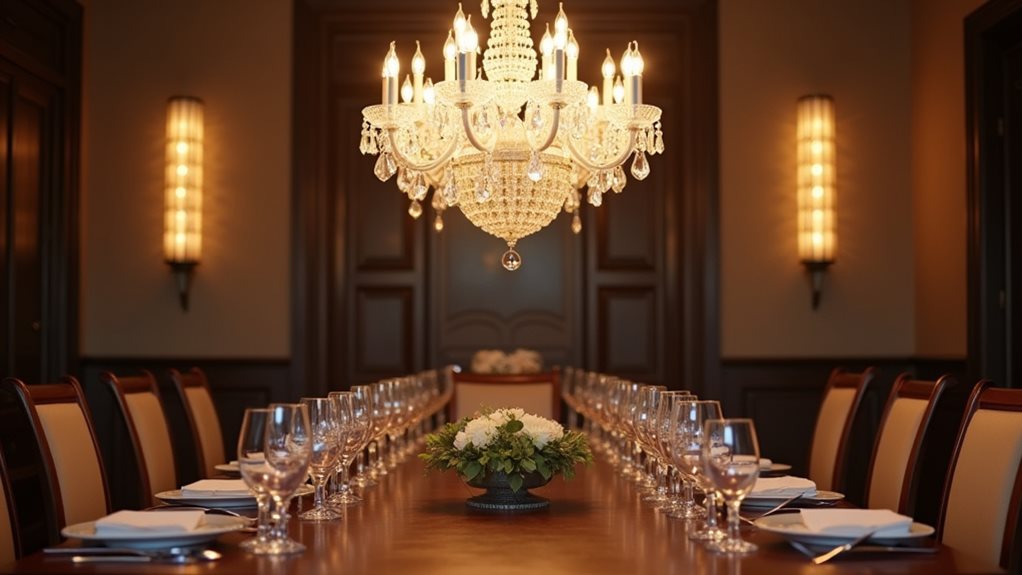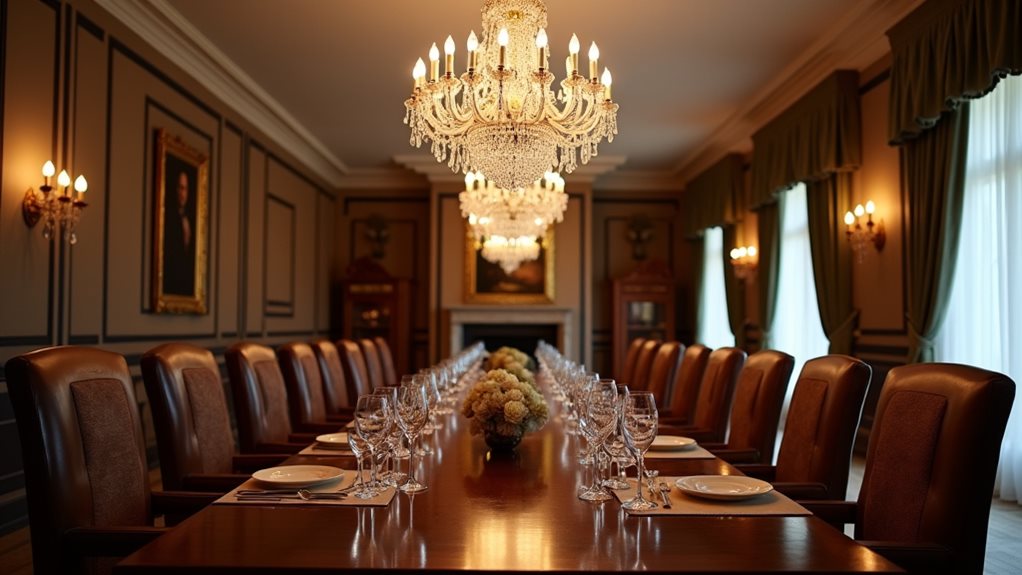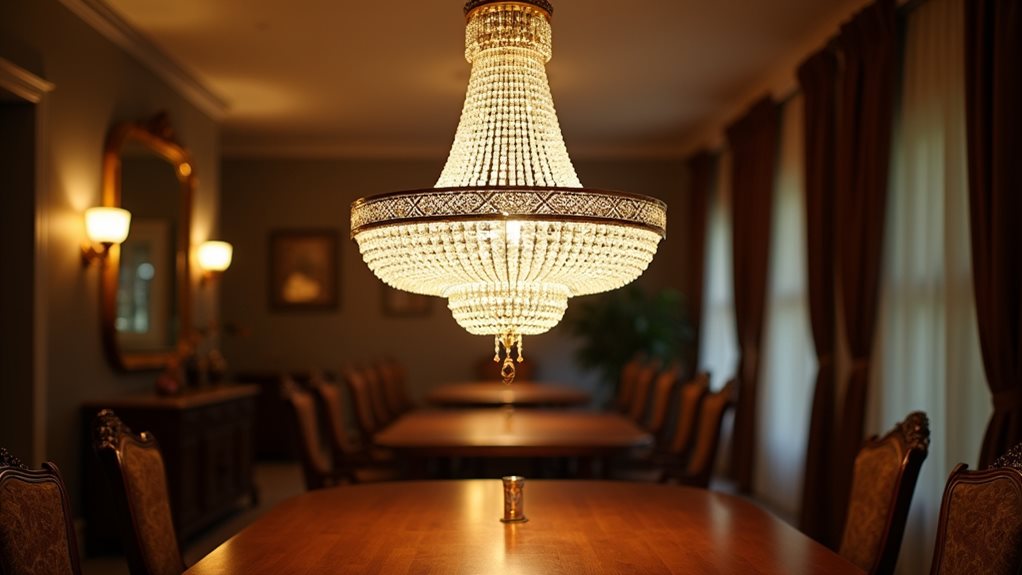Determining the ideal height for hanging your chandelier involves a delicate balance of aesthetics, space, and safety. Factors such as ceiling height, room dimensions, and the fixture’s size must be meticulously considered. Clearance, typically 7 feet from the floor, ensures safe passage below the chandelier. Additional adjustments become necessary for varying ceiling heights and slopes, with higher ceilings requiring higher placements. Further exploration reveals how to harmonize these elements for a perfect installation.
Key Takeaways
- Ensure at least 7 feet clearance from floor to bottom of chandelier in living spaces
- Increase clearance to 8 feet above tubs or showers in bathrooms for safety
- Adjust chandelier height based on ceiling height, aiming for 30-36 inches above tables
- Add 3 inches of height for each additional foot of ceiling above 8 feet
- Center the chandelier over the focal point, considering room dimensions and function
Understanding Clearance and Safety

In designing a space with a chandelier, understanding clearance and safety is paramount. Fixture clearance is not just about aesthetics but also about adhering to safety regulations to prevent accidents. General guidelines dictate that a minimum of 7 feet of clearance should be maintained from the floor to the bottom of the chandelier in most spaces.
However, areas such as bathrooms require at least 8 feet of clearance above the tub or shower to minimize the risk of electrical dangers. Compliance with UL and CSA standards ensures that the materials used are non-hazardous and have passed safety checks for fire resistance and electrical insulation.
In bathrooms, ensure at least 8 feet of clearance above tubs and showers for chandeliers to mitigate electrical risks.
Safety regulations must be strictly followed to ensure that the installation is secure. This includes using approved materials and compliance checks with organizations like UL and CSA, as well as local building codes. Properly grounding and insulating wiring is essential to prevent electrical shocks or fire hazards.
Regular maintenance and inspections are also crucial to identify and rectify any potential issues before they become hazardous. Chandelier maintenance intervals may vary depending on the fixture’s location and the environment it is exposed to; for instance, those in damp or high-traffic areas may need more frequent checks.
In dining rooms and above kitchen islands, chandeliers should be hung at a height that allows for both illumination and safety, typically 30-36 inches above the surface. Following these guidelines ensures that the chandelier not only enhances the aesthetic of the space but does so in a manner that prioritizes the well-being of those within it.
Adjusting for Ceiling Height Variations

As interior spaces vary significantly in ceiling heights, adjusting the placement of a chandelier becomes a critical aspect of both design and function.
Height adjustments are essential to accommodate different ceiling slopes and maintain a balanced aesthetic. For standard ceilings, a clearance of at least 7 feet is recommended, while higher ceilings require additional inches to the chandelier’s hanging height.
Vaulted ceilings introduce the complexity of the slope angle, which necessitates personalized adjustments for optimal visual impact and safety. In rooms with sloped ceilings, the pitch of the slope alters the drop of the chandelier, contrasting with the uniform adjustments possible in spaces with flat ceilings.
Thus, the interplay between ceiling height variations and chandelier placement is crucial for achieving a harmonious and well-lit environment.
Sizing Your Chandelier Appropriately

Selecting the right size for a chandelier is crucial to both the function and aesthetic of a space. The diameter of the fixture should be considered in relation to the room’s dimensions, often adhering to the formula of adding the room’s length and width in feet and converting the result to inches.
Additionally, the visual weight of the chandelier, influenced by its style and design, should be balanced with the proportions of any furniture it may hang above, such as dining tables, to ensure a harmonious visual impact.
Diameter and Room Size
Chandelier diameter and room size intertwine to create a harmonious aesthetic. To ensure a balanced look, chandelier dimensions should be carefully selected based on the room’s shape and size.
For rectangular rooms, longer, horizontal chandeliers that mirror the room’s form are often ideal. The diameter can be calculated by adding the room’s length and width in feet and converting this sum to inches.
Additionally, the chandelier’s visual design can influence its perceived size; ornate fixtures tend to appear larger than their actual dimensions. By considering these factors, one can achieve a cohesive and visually pleasing integration of the chandelier within the room’s overall design.
Proportions Over Tables
When hanging a chandelier above a table, it’s crucial to consider height proportions to achieve both functional and aesthetic balance. Guidelines suggest positioning the fixture 30 to 36 inches above the table surface, ensuring clearance for diners and creating a visually pleasing focal point.
Factors such as ceiling height, table dimensions, and the chandelier’s style influence the ideal hanging height. For example, higher ceilings allow for higher placement, while elaborate designs may benefit from a slightly elevated position to showcase their details.
Balancing the chandelier’s proportions with the table’s aesthetics results in a harmonious and inviting dining space.
Visual Weight Impact
In dining and living spaces alike, the visual weight of a chandelier plays a pivotal role in shaping the room’s ambiance and functionality.
The design, material, and size of a chandelier significantly influence its visual perception and how it interacts with the surrounding space.
To achieve a balanced and aesthetically pleasing environment, consider the following factors:
- Chandelier Design: Ornate designs tend to appear heavier, while minimalist designs seem lighter. The choice of design should complement the room’s decor.
- Material Impact: Materials such as crystal or glass can make a chandelier appear lighter, affecting the room’s overall feel.
- Size and Scale: A chandelier should be proportionate to the room’s dimensions. Too large, and it overwhelms; too small, and it seems insignificant.
- Light Distribution: The way light is dispersed through the chandelier affects its visual weight, contributing to the room’s ambiance.
Practical Installation Advice

Proper installation of a chandelier involves careful measurement and adherence to safety protocols. Measurements should account for the room’s dimensions, ceiling height, and the chandelier’s size to ensure it hangs at an optimal height that balances aesthetics with functionality.
Safety considerations include confirming the ceiling’s weight-bearing capacity, ensuring stable and level installation, and addressing electrical connections to prevent hazards.
Measurement Techniques
Accurate measurements are crucial for the proper installation of a chandelier, ensuring both aesthetic appeal and functional lighting.
Utilizing precise measurement tools and geometric techniques, installers can achieve the perfect placement. Incorporate the following steps to ensure accuracy:
- Measure the Room: Calculate the room’s dimensions to determine the ideal chandelier diameter and height, maintaining proportions with the space.
- Determine Hanging Height: Use a measuring tape to find the optimal distance from the ceiling, considering the room’s purpose—such as clearance above a dining table or bedroom furniture.
- Assess Chain Length: Measure from the ceiling hook to the desired bottom of the chandelier, adjusting chain links as necessary for perfect suspension.
- Center the Fixture: Ensure the chandelier is centered over the focal point, using a plumb bob or laser level for precision alignment, thereby enhancing the overall aesthetic and light distribution.
Safety Considerations
While installing a chandelier, safety must be the foremost concern to prevent accidents and ensure the fixture’s longevity.
Electrical safety is paramount; proper wiring, grounding, and secure connections must be established, with all power turned off during installation.
The chandelier’s structural integrity relies on the ceiling’s weight capacity and the use of reinforced support if necessary.
Fire prevention measures include using correct bulb wattage and maintaining clearance from flammable materials.
Physical safety during installation involves a stable ladder, protective gear, and possibly professional assistance for complex setups.
Adhering to these safety considerations not only prevents mishaps but also ensures the chandelier enhances the space both aesthetically and functionally.
Avoiding Common Placement Errors

Chandeliers, when improperly placed, can disrupt the harmony and functionality of a room. To avoid common placement pitfalls and achieve optimal lighting balance, consider the following guidelines:
Improper chandelier placement can disrupt a room’s harmony and functionality. Follow these guidelines to achieve optimal lighting balance and avoid common pitfalls.
- Measure ceiling height accurately to determine the appropriate hanging height, adding 3 inches for each additional foot above 8 feet.
- Ensure the chandelier is hung at least 7 feet above the floor in open living spaces to prevent obstruction and maintain clear sightlines.
- In dining areas and over kitchen islands, hang the fixture 30-36 inches above the table or countertop for effective illumination without overwhelming the space.
- Use a consistent formula based on room dimensions and intended use to find the ideal height, promoting a well-balanced and aesthetically pleasing lighting scheme throughout the room.
Harmonizing With Room Aesthetics

To seamlessly integrate a chandelier into a room’s design, it is crucial to consider the existing decor and architectural features.
The style of the chandelier should align with the overall design theme, whether it be modern, traditional, or eclectic, to maintain aesthetic harmony. Proportion plays a significant role; the chandelier’s size must be appropriate for the room dimensions to prevent visual imbalance.
When selecting a chandelier, factor in the room’s function and how the fixture will contribute to the ambient lighting. Color coordination between the chandelier and the room’s palette ensures a cohesive appearance.
Placement should be strategic, ensuring the chandelier serves as the focal point without overwhelming other design elements. By thoughtfully considering these aspects, a chandelier can enhance the room’s aesthetic while providing functional and beautiful ambient lighting.



Bài viết cùng chủ đề:
5 Old Chandeliers for Sale Cheap Available Now
Black Chandeliers Transform Dining Room Ambiance
5 Elegant Crystal Chandeliers That Transform Dining Rooms
5 Stunning Gold Dining Room Light Fixtures for 2025
5 Traditional Chandeliers That Transform Dining Rooms
How to Choose the Perfect Linear Chandelier Over Your Dining Table